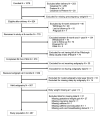Night-time sleep duration and postpartum weight retention in primiparous women
- PMID: 38314118
- PMCID: PMC10838128
- DOI: 10.1093/sleepadvances/zpad056
Night-time sleep duration and postpartum weight retention in primiparous women
Abstract
Objectives: Approximately 75% of women weigh more at 1-year postpartum than pre-pregnancy. More than 47% retain >10 lbs at 1-year postpartum, which is associated with adverse health outcomes for mother and child. Disturbed sleep may contribute to risk of postpartum weight retention (PWR) as short sleep duration is associated with increased risk of obesity. Thus, we investigated whether night-time sleep duration is associated with risk for excessive PWR. We also explored night-time sleep duration and change in postpartum waist circumference.
Methods: This is an ancillary analysis from a prospective cohort study. Participants were healthy primiparous adults with a singleton birth. Excessive PWR at 1-year postpartum was defined as ≥7% of pre-pregnancy weight. Log-binomial and linear regression assessed associations between night-time sleep duration at 6 months postpartum and PWR at 1-year postpartum. Linear regression assessed the association between night-time sleep duration and change in postpartum waist circumference.
Results: Mean age of participants (N = 467) was 29.51 (SD ± 4.78) years. Night-time sleep duration by actigraphy or self-report was not associated with risk for excessive PWR (risk ratio 0.96, [95%CI 0.87-1.06]; risk ratio 0.95 [95%CI 0.83-1.07], respectively) or change in waist circumference.
Conclusion: Night-time sleep duration at 6 months postpartum was not associated with PWR at 1-year postpartum. Mixed findings among our results and previous research could be due to our focus on night-time sleep, and differences in sleep measurement methods and timeframes across studies. More comprehensively assessing sleep, including multiple sleep dimensions, may help advance our understanding of potential links between sleep and PWR.
Trial registration: The parent study, Motherhood and Pelvic Health (MAP Study), is registered at https://clinicaltrials.gov/ct2/show/NCT02512016, NCT02512016.
© The Author(s) 2023. Published by Oxford University Press on behalf of Sleep Research Society.
Conflict of interest statement
C.M.D. reports during the conduct of the study receiving personal fees from Elsevier Inc. All other authors report none.
Figures




Similar articles
-
Dose-Response Relationships between Breastfeeding and Postpartum Weight Retention Differ by Pre-Pregnancy Body-Mass Index in Taiwanese Women.Nutrients. 2020 Apr 11;12(4):1065. doi: 10.3390/nu12041065. Nutrients. 2020. PMID: 32290407 Free PMC article.
-
Postpartum weight trajectories in overweight and lean women.Midwifery. 2017 Jun;49:134-141. doi: 10.1016/j.midw.2016.08.010. Epub 2016 Sep 2. Midwifery. 2017. PMID: 27638342
-
The influence of psychological factors on post-partum weight retention at 9 months.Br J Health Psychol. 2014 Nov;19(4):751-66. doi: 10.1111/bjhp.12074. Epub 2013 Oct 26. Br J Health Psychol. 2014. PMID: 25295695
-
Associations of sleep characteristics with outcomes of IVF/ICSI treatment: a prospective cohort study.Hum Reprod. 2022 May 30;37(6):1297-1310. doi: 10.1093/humrep/deac040. Hum Reprod. 2022. PMID: 35259255
-
Relationship between night-sleep duration and risk for depression among middle-aged and older people: A dose-response meta-analysis.Front Physiol. 2023 Mar 2;14:1085091. doi: 10.3389/fphys.2023.1085091. eCollection 2023. Front Physiol. 2023. PMID: 36935736 Free PMC article.
References
Associated data
Grants and funding
LinkOut - more resources
Full Text Sources
Medical

